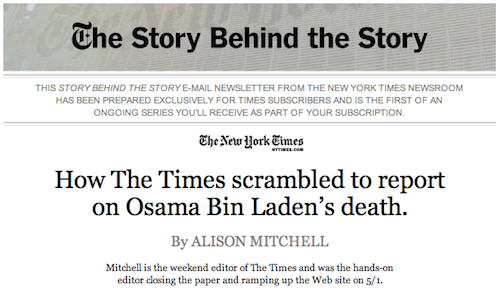
Subscribers to The New York Times got a surprise in their inboxes this afternoon: a story-behind-the-story about the paper’s coverage of the death of Osama bin Laden, penned by the weekend editor who’d been helming the paper’s news coverage when it was announced that the terrorist leader had been killed by American commandos.
The story is the first, the email notes, in an ongoing series of occasional newsletters — created for subscribers, and for subscribers alone, as, ostensibly, a “thank you” for their subscriptions. As the Times puts it (we’ll save you the ALL CAPS):
This Story Behind Behind the Story e-mail newsletter from The New York Times newsroom has been prepared exclusively for Times subscribers and is the first of an ongoing series you’ll receive as part of your subscription.
The Times’ pay models, both of them, have been based on the walling-off (or metering-off, as it were) of existing content; this seems to be a case of the Times creating new content only for its subscribers. And it’s meta-content: a story about how the Times reported a story.
I’ve reached out to the Times to learn more about the mechanics of the newsletter, which seems to be dribbling out to (at least) print subscribers this afternoon. (Some of my questions: Is it being delivered to digital Times subscribers too? How often will the newsletters be sent out? Will the stories contained in the letter — the Osama backgrounder looks oddly formatted for the page and PDF-like — live anywhere on the web or in print, or are they email-only? Will there someday be ads against the newsletters?)
I’ll update this when I hear back. Meantime, though, it’s worth noting that the newsletter is launching against the backdrop of a Times digital subscription model that is still, in the scheme of things, nascent. The pitch the paper has been making since March, after all, has been something along the lines of “we’re worth paying for.” Subscriber-only content, however, suggests an addendum to that: “We’ll make the paying-for worthwhile.” It rewards subscription, obviously — but, in that, it also suggests that subscribers are, somehow, insiders. News organizations often default to that “behind the scenes” approach when considering how to reward devoted readers: Intimacy, after all, can be a good complement to loyalty.
It’s also worth noting why the Times can reward its subscribers via email. One advantage of the paper’s paid-content model — besides, you know, getting your readers to pay for the content they consume — is how it incentivizes subscribers to connect their digital and print accounts. (Print subcriptions get digital access, but only if they connect the two.) The Times can reach its subscribers (and reward them, then, however it sees fit) in some part because the paper has their digital information in the first place. Times Co. CEO Janet Robinson noted last month that 728,000 print subscribers had connected newsprint to website. Users have given the Times their data; the Times has used those data, in turn, to thank them.
In that, the newsletter seems to be a step toward the Times converting its subscriber base into something that looks more like a community. The Times itself has, in the past, considered “membership” as the proper metaphor for a paid-content strategy — remember those rumors of Gold and Silver offerings? While it ultimately opted for a subscription-driven approach rather than a membership-driven one, the special-for-subscribers content tips a hat to the core ideas of media membership. It’s a like a tote bag in story form.
And that’s significant. The conventional wisdom, after all, tends to be that creating community around news content is the first step toward monetizing that content. The Times’ pay meter has so far bucked that assumption, making its pitch mostly about the paper’s value to consumers on an individual level. Today’s inaugural newsletter suggests, though, that the paper is still actively exploring the more communal aspects of paid content — in this case, bolstering its brand by rewarding the people who prove willing to pay to keep it around.